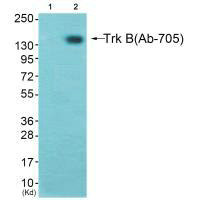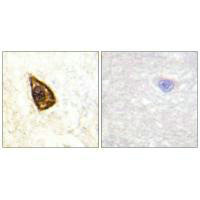
Western blot analysis of extracts from K562 cells (Lane 2), using Trk B (Ab-705) antiobdy. The lane on the left is treated with synthesized peptide.
NTRK2 Antibody
CSB-PA936032
ApplicationsWestern Blot, ELISA, ImmunoHistoChemistry
Product group Antibodies
ReactivityHuman, Mouse
TargetNTRK2
Overview
- SupplierCusabio
- Product NameNTRK2 Antibody
- Delivery Days Customer20
- ApplicationsWestern Blot, ELISA, ImmunoHistoChemistry
- CertificationResearch Use Only
- ClonalityPolyclonal
- ConjugateUnconjugated
- Gene ID4915
- Target nameNTRK2
- Target descriptionneurotrophic receptor tyrosine kinase 2
- Target synonymsBDNF/NT-3 growth factors receptor; BDNF-tropomyosine receptor kinase B; DEE58; EIEE58; GP145-TrkB; neurotrophic tyrosine kinase receptor type 2; OBHD; TRKB; trk-B; tropomyosin-related kinase B; tyrosine kinase receptor B
- HostRabbit
- IsotypeIgG
- Protein IDQ16620
- Protein NameBDNF/NT-3 growth factors receptor
- Scientific DescriptionReceptor tyrosine kinase involved in the development and the maturation of the central and the peripheral nervous systems through regulation of neuron survival, proliferation, migration, differentiation, and synapse formation and plasticity. Receptor for BDNF/brain-derived neurotrophic factor and NTF4/neurotrophin-4. Alternatively can also bind NTF3/neurotrophin-3 which is less efficient in activating the receptor but regulates neuron survival through NTRK2. Upon ligand-binding, undergoes homodimerization, autophosphorylation and activation. Recruits, phosphorylates and/or activates several downstream effectors including SHC1, FRS2, SH2B1, SH2B2 and PLCG1 that regulate distinct overlapping signaling cascades. Through SHC1, FRS2, SH2B1, SH2B2 activates the GRB2-Ras-MAPK cascade that regulates for instance neuronal differentiation including neurite outgrowth. Through the same effectors controls the Ras-PI3 kinase-AKT1 signaling cascade that mainly regulates growth and survival. Through PLCG1 and the downstream protein kinase C-regulated pathways controls synaptic plasticity. Thereby, plays a role in learning and memory by regulating both short term synaptic function and long-term potentiation. PLCG1 also leads to NF-Kappa-B activation and the transcription of genes involved in cell survival. Hence, it is able to suppress anoikis, the apoptosis resulting from loss of cell-matrix interactions. May also play a role in neutrophin-dependent calcium signaling in glial cells and mediate communication between neurons and glia. Nakagawara A., Genomics 25:538-546(1995). Shelton D.L., J. Neurosci. 15:477-491(1995). Allen S.J., Neuroscience 60:825-834(1994)
- ReactivityHuman, Mouse
- Storage Instruction-20°C or -80°C
- UNSPSC12352203

